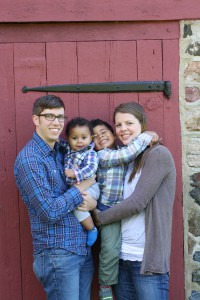Editor’s note: Attachment Parenting International (API) hopes every mom enjoyed her Mother’s Day on May 10 and every dad is looking forward to Father’s Day on June 21. This week, in honor of all mothers, API gives you a special “Inspired Mothers” celebration. We hope these posts inspire you in your parenting journey.
The road to forming your family through adoption, and thus becoming a mother, can be long.
Various interviews, paperwork, letters of reference and physician referrals that are required before you are considered eligible can make the process of becoming a parent seem tedious. As you wait and yearn to care for a child, it can become difficult to see other couples and families receive referrals or become matched. At times, the wait may seem unbearable.
Yet, you still need to prepare physically and emotionally and be ready for your little one to arrive. So, like any parents anxious to build their family, you turn to blogs, books, anything that will give you a glimpse of what a family formed through adoption looks and feels like. You decide upon things like cosleeping or nursery, bottle-feeding or breastfeeding, open or closed adoption.
While waiting to grow our family, my husband and I researched it all. Yet, no matter how many books we read or blogs we followed, nothing could have prepared us for that moment: sitting across from this woman, seeing both the pain and joy in her eyes, watching her hold our son.
Up until this moment, preparing to meet our son, I had been focusing on how to care for a baby, not how to emotionally connect with my son and the woman who gave him life and love — his birth mother.
As I watched her and heard the palpable mix of loss and love in her voice, I learned more than a blog or book could ever teach me. My husband and I left this conversation with our son’s birth mother with a seemingly conflicting sense of sadness and loss but also joy. We renewed our determination to provide both of our sons with greater security, tangible love and a concrete sense of confidence in themselves, knowing they are loved beyond measure. I learned the love of a birth mother and how that love would transform our sons’ lives and ultimately encourage me to be a better mother myself.
The love of a birth mother is at times sacrificial and gives life and possibility, not only to the precious life brought into this world but also to the adopting mother and family. This love allowed me to experience motherhood, to see my children’s first smiles and hear their first laughs, to hold my boys close and dry away tears, and to receive unconditional love from two wonderful beings. It encourages me to seek everyday moments of connection through activities, such as light saber battles and family football games, strengthening the bonds that I have with my sons.
The knowledge of this first love sparks honest and empathetic conversation within our family. When my older son asks, “Where did my baby brother come from?” I am able to openly tell him a story of a woman who loved his baby brother and carried him in her belly, ultimately allowing us to grow our family, just like his own birth mother did before he was born. Responding sensitively with empathy and love as we talk about their birth mothers, or first families, allows me to build trust with my sons, sharing in their developing emotions.
On this year’s Mother’s Day, I celebrated more than being a mom myself and being blessed with a compassionate mother and caring grandmothers. I’m celebrating the courageous women — the other mothers — who granted me the amazing gift of becoming a mom.



